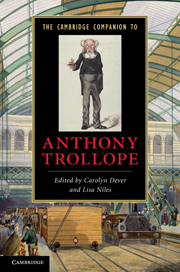Book contents
- Frontmatter
- Introduction
- 1 Trollope’s Literary Life and Times
- 2 Trollope As Autobiographer And Biographer
- 3 Trollope’s Barsetshire Series
- 4 The Palliser Novels
- 5 Trollope Redux: The Later Novels
- 6 Trollope’s Short Fiction
- 7 Trollope And The Sensation Novel
- 8 Queer Trollope
- 9 The hobbledehoy in Trollope
- 10 The construction of masculinities
- 11 Vulgarity and money
- 12 Trollope and the law
- 13 Trollope and travel
- 14 Trollope and the Antipodes
- 15 Trollope and Ireland
- 16 Trollope and America
- Further reading
- Index
- Cambridge Companions to . . .
Introduction
Published online by Cambridge University Press: 28 March 2011
- Frontmatter
- Introduction
- 1 Trollope’s Literary Life and Times
- 2 Trollope As Autobiographer And Biographer
- 3 Trollope’s Barsetshire Series
- 4 The Palliser Novels
- 5 Trollope Redux: The Later Novels
- 6 Trollope’s Short Fiction
- 7 Trollope And The Sensation Novel
- 8 Queer Trollope
- 9 The hobbledehoy in Trollope
- 10 The construction of masculinities
- 11 Vulgarity and money
- 12 Trollope and the law
- 13 Trollope and travel
- 14 Trollope and the Antipodes
- 15 Trollope and Ireland
- 16 Trollope and America
- Further reading
- Index
- Cambridge Companions to . . .
Summary
Anthony Trollope was one of the most prolific, popular, and richly diverse Victorian writers. In a literary career that extended from the 1840s to the 1880s, Trollope published forty-seven novels, including the monumental Barsetshire and Palliser series and such major stand-alone works as Orley Farm (1862) and The Way We Live Now (1875). A serial and series writer whose novels traverse Ireland, England, Australia, and New Zealand and genres from realism to science fiction, Trollope also published criticism, short fiction, travel writing, and biography; his Autobiography, published posthumously, codified – in terms best described as notorious – the labor practices of the professional Victorian writer. At the peak of his career Trollope’s standing was well established among both literary and popular readers. His reputation declined rather precipitously after his death, however, when his Autobiography pulled the curtain from a writing process that included a firm commitment to the production of a certain number of words each day, and a muse who kept an unblinking eye trained on the sales figures. Yet, even in the midst of what appeared to be an irrevocable critical decline, Trollope remained in print. He was always read. This unbroken continuity has something to tell scholars about the cultural relevance of Trollope’s work.
- Type
- Chapter
- Information
- The Cambridge Companion to Anthony Trollope , pp. 1 - 5Publisher: Cambridge University PressPrint publication year: 2010

